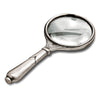Tolomeo Magnifying Glass - 17 cm Length - Handcrafted in Italy - Pewter & Glass
A classic instrument of magnification, this pewter magnifying glass, handcrafted by Italian pewter craftsmen, is the perfect addition to a desktop, enabling the reading of small-print, as well as being a useful paperweight. It is the perfect gift for anyone who enjoys authentic and traditional objects.
Buying as a gift? Why not make it even more special with our engraving service?
The pewter handles of our magnifying glasses are attached using a special technique: the molten pewter is directly cast onto the lens to form what is really a single element in which the "hardness" of the glass of the lens discreetly dissolves into the "soft" surface of the pewter handle.
HISTORY OF LENSES
The use of lenses as a corrective system for the eyesight is said to date back to the Roman emperor Nero who, it seems, used an emerald as a monocle, though not much credence should be given to this story. About 150 AD, Ptolemy discovered certain fundamental repetitive optical phenomena concerning the refraction of light and wrote extensively on the subject. During the 12th Century, only some magnification systems were known. These made use of simple pieces of concave or convex glass that did not give a real picture of things. They were not widely used because they distorted reality. The first documentary evidence of lenses being used to correct eyesight dates back to 13th Century Europe. Basing themselves on the theories of the Arab mathematician, Alhazen, medieval monks invented the so-called "reading stone" which they used to transcribe old books. This mainly consisted of rock crystal.
The first person to describe the use of lenses to improve eyesight was Roger Bacon in 1262. He made various experiments with lenses and mirrors and described the principles of reflection and refraction. Roger Bacon was admired and protected by Pope Clement IV, but when the Pope died he had to continue his studies in secret. He was discovered, accused of heresy and put in prison. When he was eventually released, he continued his experiments but 300 years went by before Snellius formulated the laws of refraction between 1600 and 1620.
Size: Length 17 cm
Weight: 207 g
Materials Used: Pewter
Ref: CT0100301
Designers: Enrico Cosi & Sergio Tabellini
100% Lead Free
All Cosi Tabellini Pewter is 100% lead-free, so it is totally food & drink safe, and is both EU and US FDA approved.
Packaging
Cosi Tabellini pieces come gift-boxed with a guarantee card and instructions on how to care for pewter.




